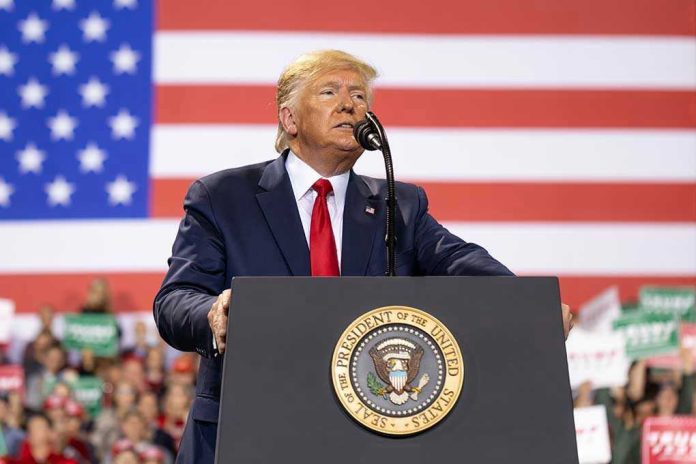
What would it mean for millions of Americans if IVF treatments suddenly became as accessible as aspirin—and just as affordable?
Story Snapshot
- Trump announces plan to expand IVF access with employer coverage and discounted fertility drugs
- Policy aims to lower out-of-pocket IVF costs and increase birth rates
- Private sector and pharmaceutical partnerships set to reshape fertility market
- Move sparks debate over healthcare priorities and family-building in America
Trump’s IVF Expansion Plan Shakes Up the Fertility Conversation
President Donald Trump has unveiled a sweeping initiative to expand in vitro fertilization (IVF) access across the United States, promising to reshape the landscape for families struggling with infertility. The plan’s core provisions include employer-mandated coverage options and a partnership-driven approach to slash prices on key fertility drugs. By targeting one of the most prohibitive barriers—cost—this policy aims to open the door for millions who have long regarded IVF as financially out of reach.
The announcement is more than a healthcare policy tweak; it signals a cultural pivot. For decades, IVF has symbolized hope tinged with heartbreak, its promise often dampened by a price tag that can soar well beyond $15,000 per cycle. Trump’s plan, if implemented, would force insurers and employers to step up, offering coverage that many have previously withheld. By negotiating with pharmaceutical companies to cut fertility drug costs, the administration claims families could see savings up to 60%. The implications reach far beyond individual households, potentially altering demographic trends and economic forecasts alike.
Economic and Demographic Stakes: Why Fertility Policy Matters Now
The United States faces a declining birth rate—a trend that alarms policymakers concerned about the long-term health of the economy and social safety nets. Trump’s IVF expansion plan enters this arena as both a practical healthcare solution and a strategic population policy. If more Americans can afford to have children, the thinking goes, the nation may begin to reverse years of demographic stagnation. The proposal’s insistence on employer involvement could also trigger a wave of corporate benefit reforms, as businesses compete for talent in a tight labor market by sweetening family-building packages.
President Trump on Thursday announced a pair of efforts aimed at expanding access to in vitro fertilization (IVF) as he seeks to deliver on a major campaign promise.https://t.co/HXpqLCOALK
— fox8news (@fox8news) October 16, 2025
Insurers and pharmaceutical giants are not likely to embrace these changes without a fight. Critics warn that forced coverage mandates and price controls could drive up premiums or spark supply shortages. Yet, supporters argue that the societal benefits—higher birth rates, reduced long-term healthcare costs associated with delayed parenthood, and greater workforce stability—far outweigh transitional pains. As the debate intensifies, the question looms: Can government intervention truly solve the fertility crisis without unintended consequences?
Healthcare, Values, and the IVF Debate: Conservative Perspectives
Trump’s IVF initiative has ignited vigorous debate among conservatives. Some hail the move as a pro-family, pro-life policy designed to strengthen the American fabric by supporting couples who wish to have children. They argue that lowering IVF costs aligns with traditional values by empowering families and combatting the demographic decline threatening the nation’s future. Others, however, remain wary of deeper government involvement in private healthcare decisions, questioning the wisdom of mandates and the potential for price distortions in the pharmaceutical market.
Critics from within the party suggest that the plan may inadvertently expand the federal footprint in healthcare, a concern that sits uneasily with limited-government priorities. Proponents counter that supporting family formation is a core conservative value—and that, in this case, pragmatic policy may be the best means to uphold it. The debate reveals broader tensions within conservatism: the balance between free-market principles and the desire to safeguard the institution of the family.
Winners, Losers, and the Road Ahead in Fertility Policy
If successful, Trump’s IVF expansion could spark a sea change for millions hoping to build families. Lower drug prices and employer-based coverage may make what was once unattainable a new normal for middle-class Americans. The pharmaceutical industry could face margin pressures, but increased demand might offset losses. Insurers may resist, but competition for talent could eventually force their hand. The broader cultural impact—making family-building more accessible and less stigmatized—could outlast any single administration’s legacy.
As the nation watches the policy debate unfold, one fact remains clear: the intersection of healthcare, economics, and values will shape not only who gets to have children, but what kind of future America chooses for itself. The coming months will reveal whether Trump’s bold bet on IVF is a political masterstroke, a practical solution, or the start of a new chapter in the ongoing struggle over healthcare and family policy.
Sources:
USA Today: Trump unveils IVF expansion plan with major drug price cuts










